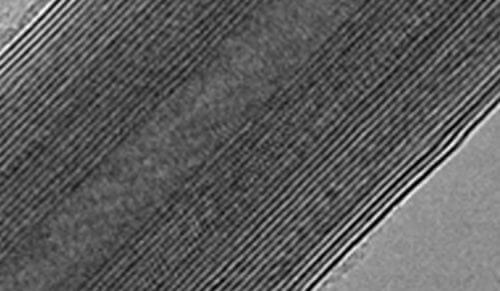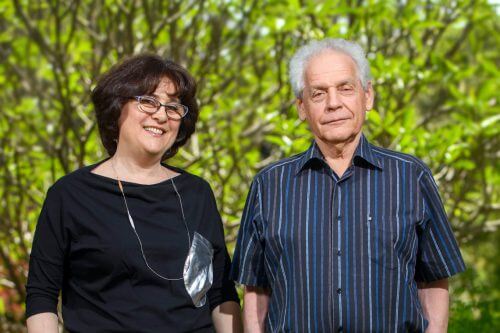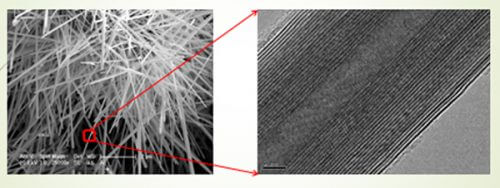Weizmann Institute of Science scientists and their research partners discovered that nanotubes from the compound WS2 trap light in their cores and produce an electric current in response. The measured photovoltaic effect is the most powerful of its kind observed so far

A tiny tube, shaped like a hollow cigar, made of an inorganic compound wrapped around itself, may become one of the smallest solar devices in the world. This discovery - the result of a collaboration between physicists from Japan and Germany and chemists from Israel - is surprising not only due to the fact that a nanotube produces electrical energy from sunlight, but because it is the most powerful effect observed so far of a unique physical mechanism, known as the "anomalous photovoltaic effect" .
For more than 25 years Prof. Reshef Tana, from the Department of Materials and Surfaces at the Weizmann Institute of Science, has been creating and researching nanostructures made of various inorganic compounds. "Carbon nanotubes are indeed the most well-known, but many different compounds can be turned into nanotubes," says Prof. Tana. Nanotubes from the compound tungsten disulfide (WS2) were the first he created, and they were discovered to be nanoconductors with impressive mechanical strength. Prof. Ella Zak from the Holon Institute of Technology - who was one of Prof. Tana's first students, and later became his partner - studied the growth mechanism of WS2 nanotubes in great detail, and was the first to propose a reaction mechanism for their creation in pure phases and in large quantities.

In recent years, their joint research turned in a new direction: they joined forces with Prof. Yoshihiro Iwasa - a physicist from the University of Tokyo and the RIKEN Institute, who deals with the physical properties of nanotubes. After these properties were extensively demonstrated for carbon nanotubes, Prof. Iwasa turned to Professors Zack and Tana to also examine the physical properties of lesser-known types of nanotubes. In their first series of experiments, the results of which were published in the scientific journal Nature Communications, the researchers discovered that WS2 nanotubes can become superconductors at low temperatures; Similar to other types of semiconductors that operate at low temperature, the electrons in the nanotubes move through the material in pairs, encountering no resistance in their path. In a study published in the journal Nano Letters, the scientists have already shown that the temperature at which the nanotube acquires superconducting properties decreases as its diameter decreases. "A puzzling finding that still requires a theoretical explanation," comments Prof. Tana.
Next, the researchers turned to investigate the optical properties of WS2 tubes. Similar to optical fibers in communication systems, the nanotubes can capture light in their hollow centers. Thus, when a polarized electric field was applied to the tubes, they glowed. In another study, led by TANA's former research student, Dr. Lena Yedgrove, it was found that nanotubes with a diameter of 100 nanometers or more can capture light in their cores, similar to optical fibers. This phenomenon raised another question: can the nanotubes, similar to solar cells, absorb light and produce electricity in response?

To test this, the research group led by Dr. Zhang Yijin, who was at the time a research student in Prof. Iwasa's group, used lasers at different wavelengths and illuminated different parts of the nanotubes with them. The inorganic nanotubes showed better results than expected, but the best results were obtained when the light beam was aimed directly at the center of the nanotube and not at its ends. This is a unique type of light absorption activity, known as the "anomalous photovoltaic effect". "Usually we would expect to see the effect closer to the edges, where the contact points may push out the electrons or the 'holes'," explains Prof. Tana. “In WS2 nanotubes, asymmetry is key; That is, the 'net' that creates each layer should be shifted from the one below it, and in the right direction." Similar to the conductivity of the nanotubes, this phenomenon, which was recently described in the journal Nature, is still not fully explained by physical theory.
Despite the particularly strong response observed by the research team, at this stage it is still not efficient enough to allow nanotubes to be incorporated into standard solar collectors. However, the scientists intend to further investigate other inorganic types of nanotubes to see if these have similar solar properties. In addition, they will continue to investigate WS2 nanotubes with the aim of increasing their light-harvesting capacity, for example, through "implantation" - the intentional addition of impurities in order to improve the flow of electrons.
Prof. Tana believes that even though the properties of the nanotubes discovered in the research considerably expand the existing knowledge about material behavior on a tiny scale, the more immediate applications of inorganic nanotubes do not lie in their photovoltaic, optical, or even superconductivity properties. But precisely in their great strength. Adding them to armored materials, for example, may significantly improve the effectiveness of protective vests, and adding them to composite materials used to build airplanes or cars, may significantly improve the ability of the latter to absorb shocks and prevent casualties in accidents. In addition, studies indicate that inorganic nanostructures such as those created by the scientists are non-toxic, and therefore in the future they will be able to find their way into various medical devices - sensors and even artificial "spare parts" of the human body.
The anomalous photovoltaic effect measured in WS2 nanotubes was 2 to 4 orders of magnitude stronger than similar effects measured in other materials, such as polar ceramic materials.
for the scientific article

3 תגובות
Regarding the sentence at the end:
"The anomalous photovoltaic effect measured in WS2 nanotubes was 2 to 4 orders of magnitude stronger than similar effects measured in other materials, such as polar ceramic materials."
I think that already today the production of electricity from a photovoltaic cell and a tai is about 15% of the possible power. (from the amount of energy in the blood rays that hit the cell)
If this is true, already one order of magnitude reaches 150% - and this is already against the law of conservation of energy. But if they manage to reach 30%, it will give impetus to the whole market.
Tungsten disulfide. In case someone wanted more in Hebrew.
I would use them to fake a superconductor.
Weave from them, at a twisting angle of about XNUMX degrees on the left.
120°\30°. (I find that with a slight change, geometry helps to understand the numbers more easily)
And dips everything in a good conductor but less**. Your two are in lower heat degrees than the fabric**.
This complex material.. while the carrier material conducts electricity, the fibers carry it more easily, thus creating an 'electrically positive' area.
And so the basic conditions for the state of a superconductor are imitated in a way that I hope satisfies.
Here is a lightweight power source that will ensure endless flight of drones and drones